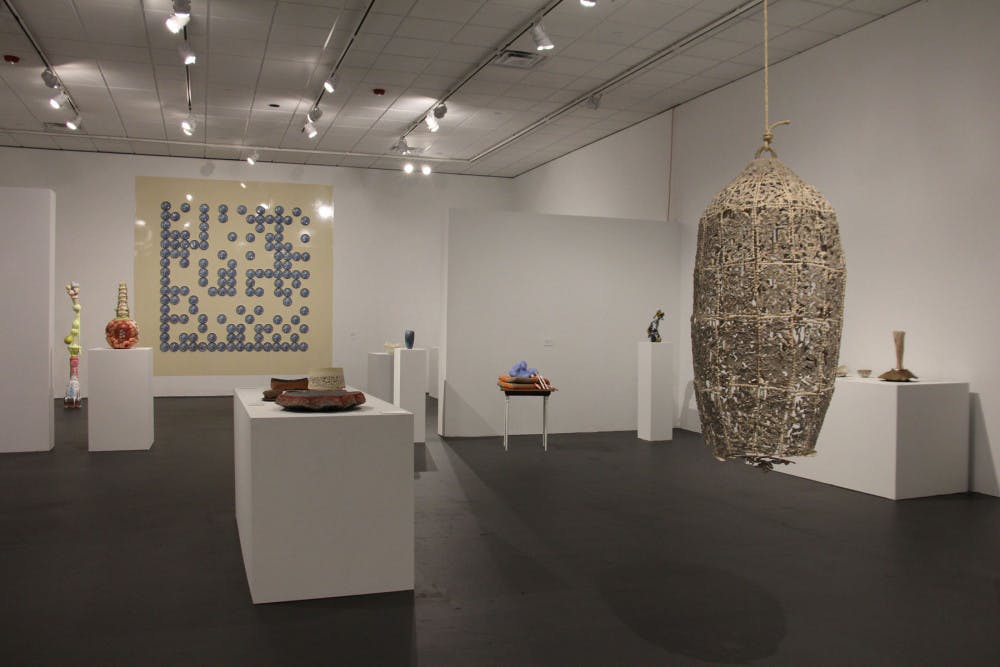Upon entering the lobby of the List Art Center, a massive pyramidal structure of stoneware and porcelain loops bombards the eye, each loop resting delicately on top of the other like an abandoned pile of pasta. A grid of what appears to be starched underwear spans the right wall of the lobby, each pair spray-painted a different metallic color and sprinkled with small pearls and rhinestones. Through the David Winton Bell Gallery’s glass doors to the right, a hanging capsule swings from the ceiling, surrounded by objects ranging from traditional pottery to abstract structures.
These works are a few of the 50 selected for the 49th annual National Council on Education for the Ceramic Arts conference, entitled “Lively Experiments.” The NCECA’s program comprises both an exhibition and a conference. The aforementioned exhibition runs from Jan. 24 to March 29, and the conference will take place in Providence from March 25 to 28. According to the Bell Gallery’s website, the works featured in the exhibition originate from 22 states, as well as Canada, Hong Kong, Italy, Romania, South Korea and Sweden. This year’s three jurors — Linda Christianson, a studio potter from Minnesota, Jo-Ann Conklin, director of the Bell Gallery and Anders Ruhwald, head of ceramics at the Cranbrook Academy of Art — handpicked the 50 ceramic works from a selection of 1,147 entries.
Christianson compared the role of a juror to that of a psychiatrist: She had to “dismiss (her) own likes and dislikes, and just look at the information presented” in the different works. The jurors, who had divergent views and opinions on the pieces of art, “argued, bargained and pled (their) cases” in order to whittle down the selection to 50 finalists, Christianson said.
The jurors faced difficulties in selecting these works with only digital representations of the 3D works to consider during the process, Conklin said. “In all media, states change,” she said, adding that for many of the selected pieces, she struggled to imagine the correct dimensions — some pieces were far larger than she had anticipated them to be, others much smaller.
Thomas Lane’s “Suburban Predators,” a large vase-like structure featuring monochrome prints of a suburban landscape on its exterior, has “a velvety quality” that digital representation does not detect, Conklin said. Brooks Oliver’s “Wobble Vessels,” a collection of four asymmetrically tilted objects made from cast porcelain, has a “rich blue color” that photographs fail to capture, she added.
The exhibition combines music and film to create a unique visual-auditory experience. “Ceramics isn’t just clay. It’s using clay along with other materials,” Christianson said. Vlad Basarab’s “The Archaeology of Memory,” a book constructed from eroded clay, sits beside a YouTube clip featuring time-lapse recordings of the clay books slowly dissolving in water. The book’s erosion “compar(es) the process of memory and its disappearance to geological transformations,” the clip indicated.
When selecting works for the exhibition, the jurors took into account the general appeal and aesthetic of the pieces, specifically their color, design and technical execution, Conklin said.
The jurors found Janet MacPherson’s “Monk” to be “wonderfully fanciful and appealing,” Conklin said. A porcelain structure of a rabbit’s head on a figure of a standing monk towers over the small animal heads at its base. Each animal’s head represents a different astrological origin.
“Structure,” a woodfire stoneware piece by Craig Hartenberger, resembles an ancient artifact with its crusty exterior, Conklin said. The work is unique in its ability to “appear skeletal, but at the same time, mechanical.”
Through their works, the artists featured in the exhibition address “the whole gamut,” Christianson said. The pieces focus on political and social issues and include historical appropriation, she said.
Jessika Edgar’s “Seated Woman,” for instance — a drooping mass spilling over the sides of a simple bar stool — serves as a reference to weight anxieties, Conklin said. Several artists attempted to “deconstruct traditional ceramic practices” in their work, Conklin added. Ginnifer O’Keefe’s “Bazket in Yeller,” a twisted basket-like figure splashed with bright yellow paint, has a “really rough, unconventional form,” Conklin said, adding that the jurors selected the piece for its lively vitality.
Both Conklin and Christianson highlighted the importance of this exhibition for the Providence and Brown communities. Featuring this exhibition in the Bell Gallery allows Brown to be part of a conversation about ceramics, Conklin said. There is a large community of people in Providence interested in ceramics, and the exhibition is a way for Brown to “be of service to and participate in this city,” she said.





